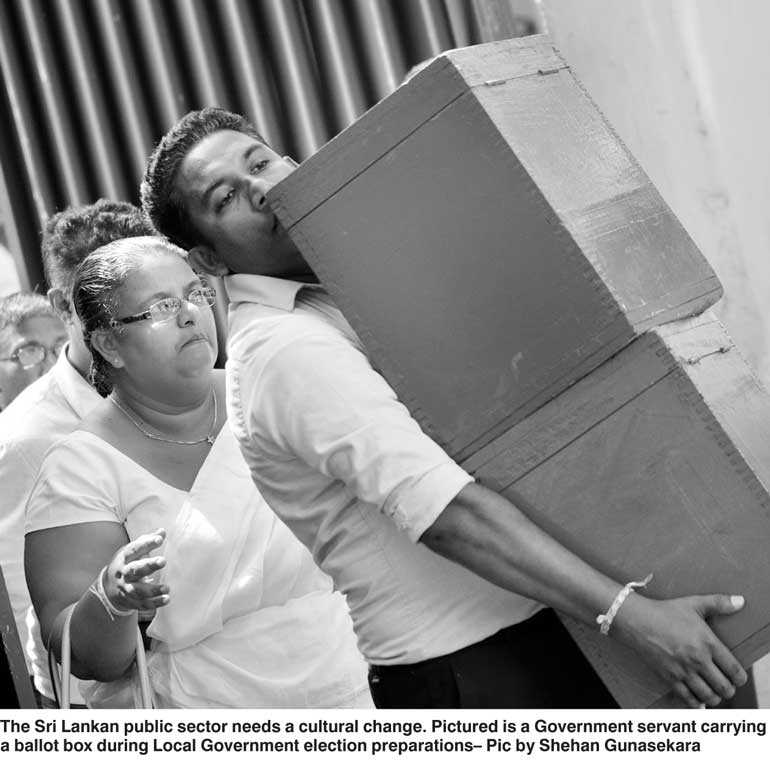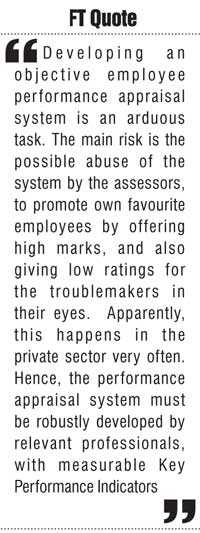Tuesday Nov 25, 2025
Tuesday Nov 25, 2025
Saturday, 13 October 2018 00:10 - - {{hitsCtrl.values.hits}}

 Hollow treatment
Hollow treatment
The Sri Lankan public sector is a symbol of equality, at least, in terms of employees’ age. I would say that the public sector is a unique place to work. Naturally, a public sector employee expresses empowerment and authority, because he or she represents the State or the Government of the day. Is this the reason that we often see stony-faced public sector officials? I don’t know. However, what I know is that, in general, their communication style is characterised with non-compromising vibes. The underlying message is that “this is the way we do business here – either accept or leave”. Hang on … ‘Leave?’ Where? There are no alternatives. So, the customers have to bite the bullet and stay for a long haul.
This is a service sector, of which an employee who delivers more than satisfactory service to the public is treated the same way as an employee who does absolutely nothing productive. Another brownie point must be given to the public sector for upholding equal treatment. This is a sector where one could move up the career advancement ladder to the extent of leading a division, or even to lead the whole organisation, for just being there, simply by counting the number of years at the seat.
What about the ability and capacity of the most senior person to do the job? How dare I ask this question? They would reply that ‘who cares whether that person did any productive work or not, as long as a few grey hairs appears on eyebrows?’
The mess
An employee performance appraisal process is non-extant in the Sri Lankan human resources management guidelines, if there is such a document in existence. Whether the public like it or not, this is the reality. More precisely, this is a situation administrators created. In my era, what was the quality of the administrators? They were the non-professional products of our education system who could cram books. They were not a bunch who had analytical, mathematical, and scientific minds. However, they were given the task of formulating administrative systems to manage public sector professionals of educational, commerce, legal, economic, engineering, medical and scientific fields.
Given their limited analytical knowledge and behavioural science, the administrators could only come up with a formula with one variable – that is the seniority based on the appointment date. There were efficiency bar exams, which were just formalities created to mask their inability to develop a proper system to assess the performance of the employees, especially the professionals. Isn’t it pathetic to see the whole country’s affairs are managed by personnel, including politicians, in the reversed order of professional intelligence?
A country needs an administrative system to promote the right people to the right positions. The current administrative system does not allow that. Hence, this system needs to be changed. It needs a visionary leader who has the mental toughness to cop trade-union attacks, and also a lot of will power, to see through this arduous journey until the objectives are achieved.
The administrators can blame the British for leaving this mess with us, but I am afraid to say that it is too late to hound them. As a matter of fact, there are no complaints from the public sector employees on this. Is it because the brightest have already left the public sector? Is it because this system works for them, as they are confident that they cannot find another job in the competitive market showing their skills? Apparently, they only complain when an employee, probably a more deserved candidate, is appointed to a position violating the “seniority list”. How about the perception of the general public about this situation? Are they happy? I am often mistaken by taking their deafening silence as a sign of approval. Maybe I am wrong.
Partners of the crime
Public sector employees are also a section of society. They may themselves feel the pain when they visit another public sector office to get their own personal affairs attended. Maybe, discreetly, they curse about the incompetence and inefficiency of the other officers. It is a known fact that public sector officers defend each other, and use personal relationships to their advantage to get personal affairs attended.
I challenge them to move out a bit from the bureaucratic web, and to do a self-reflection exercise on their own behaviour, to enlighten themselves that they are a part of the problem rather than the solution.
Let me tell you a story. Once, a very senior Sri Lankan public sector engineer, who was an employee of an Australian City Council, approached his manager and bemoaned that as a senior engineer, he should have been placed at a higher salary point with more employment benefits. The manager replied to him that he was not a ‘senior’ engineer, but an ‘old’ engineer, and advised him to apply for a ‘higher’ position by demonstrating knowledge, skills, competencies and experience, without just relying on the number of years in the profession. The Sri Lankan public sector needs a cultural change.
Solution
The immediate solution that comes to my mind is to develop a hybrid system, which counts the number of years in the profession, as well as a performance appraisal rating, to devise a seniority list. For an example, an evaluation system can consist of a certain mark out of 60 for the number of years served, and a similar mark out of 40 for the level of past and current performance. Hence, the employees could be placed in a priority list in accordance with the total marks earned at the common assessment time for the eligibility of promotions. If two employees have equal marks, they could be placed in the order of appointment date. This is easier said than done.
Developing an objective employee performance appraisal system is an arduous task. The main risk is the possible abuse of the system by the assessors, to promote own favourite employees by offering high marks, and also giving low ratings for the troublemakers in their eyes. Apparently, this happens in the private sector very often. Hence, the performance appraisal system must be robustly developed by relevant professionals, with measurable Key Performance Indicators.
 Australian approach
Australian approach
The Australian Federal and State sector has struck the balance by restricting seniority-based movement only within the grade and the class of the position, using a combined method of counting the number of years served, and a performance level (typically 1 to 5) through a structured performance appraisal system. By the way, the public sector positions are in general categorised under a grading system, and within a single grade, there is a limited number of classes (typically 3 to 5). Jumping to the next grade is completely a new ball game. It is an outcome of a new merit-based assessment process for an employee, who should compete with external and internal applicants.
In the Australian Local Government sector, the promotions are made more liberally, but the movement within a grade is based on an outcome of a structured performance evaluation system, without considering the number of years served. Hence, the two employees who joined a city council on the same day could move up in the employment ladder at different paces, based on the levels of the performance, and the person lagging behind in performance has no legal right to complain. Again, the securing of a job of the next grade is dependent on the applicant’s ability to demonstrate the suitability at an open interview, where the selection is made through a merit-based independent assessment process.
Personal anecdotes
After serving four years in a reputed semi-government organisation reporting to an international engineering consultancy entity, I entered the Sri Lankan public sector expecting the recognition of my ‘once in a lifetime’ high quality experience. I was mistaken. I was placed as an engineer equivalent to a junior engineer just graduated from a university, and offered me half of my previous salary. Fair enough, it was my choice, and I wanted to work for the public sector to make a difference to the way they do the business. I was somewhat successful as a self-motivated person.
Then, I migrated to Australia, and unwittingly faced the after-shock of my initial Sri Lankan public sector entry experience. Interestingly, they also asked me to start all over again, but for a different reason. They gave me two options. Either start again from step one and prove my worth in the long run to fast track career progress, or prove I deserve more. Basically, the Australian public sector employers challenged me to prove my knowledge, skills, and experience, without uttering experience in terms of number of years.
I took option two. I demonstrated my experience in the Sri Lankan semi-government and public sectors. They rated highly my semi-government experience (different to the Sri Lankan treatment) and my public sector experience was noted just as a footnote for future verification. Nevertheless, the employers told me that my seven years of public sector experience would be recognised in the long run, if I could apply my Sri Lankan experience at the workplace to prove its absolute worth. I did exactly that.
The ongoing employee performance appraisal systems in the Australian public sector allowed me to progress in my career, jumping from one class to the next, and also moving to three higher grades by competing with others. Their administrative set-up gave me the continuous motivation to do more productive work and enjoy work-life balance, with a decent pay packet, of course. The Sri Lankan public sector administrative system denied me this opportunity. This system denies promotion opportunities for many deserving individuals in Sri Lanka now.
The impact and the change
Sri Lanka has held on to this archaic seniority-based employee promotion system long enough. As a progressive country, rather than continually citing 2500 years of seniority, Sri Lanka must show its maturity, at least now. The immensely talented younger generation (better than my generation) is running away from the public sector, which is the backbone of governance, and some even flee from the country.
The one and only aim of the public is to send their children overseas for studies and/or permanent living. Many interactions with Sri Lankans led me to understand this common expectation, beyond any doubt. I get so many requests from unknown Sri Lankans, seeking advice on fulfilling this dream. This is a sad and also grave situation.
When an incompetent residue runs the governance machinery, what else people should do? This residue does not know how to service the machinery, and the result is defective outputs. The whole nation is paying the price for maintaining this unrepairable and unproductive machinery. Sri Lanka is running out of time and the change must happen now.
The Sri Lankan public sector needs a proper employee performance evaluation system. This outcome must be incorporated into the seniority list (currently prepared based on the commencement date of the employment), and develop a new career promotion priority list for automatic selection of staff for higher positions.
Ever-developing Sri Lanka cannot progress without having competent employees at the key public sector leadership positions. The number of years of experience is not a sole indicator of competency. How an employee applies the knowledge and skills at the work place matters the most. How the employee deals with challenges of the volatile work environment, without violating legislative requirements, and how he or she makes things happen, rather than hiding behind rules and regulations, is paramount. Such performers deserve recognition and promotions over the ‘also ran’ performers.
A sound employee performance system would eliminate the incorrigible performers and promote the best performers. It is emphasised here that the employee performance evaluation system is not designed to discourage average performers, but to assist them to understand what level of performance is expected from them, and give them a chance to work hard to reach the expected performance levels. Basically, this is not a tactical plan designed to fail the employees.
The performance appraisal model
Any employee performance appraisal model is focused on three objectives.
1.) Innovative minds: promotes employees to think out of the box and find solutions to problems hindering the provision of intended services.
2.) Career growth: this is a collaborative effort by the leader and the team member to make the team member ready to fulfil allocated duties, and at the same time to provide necessary support to develop a career progression plan.
3.) Organisational development: an organisation is only good as its employees. Although employees carry out duties individually, they must perform as an integrated team. This team performance will lead to developing a values based organisation culture. Eventually, the organisation will prosper as an efficient and effective entity.
 Key elements
Key elements
nOrganisation structure: In Australia, public sector organisations review and re-set organisational structure approximately every four years, in line with the political life cycle (elections). This is not to appoint political supporters. This is to realign organisational vision, mission, and objectives, in line with vision and policies of the government of the day, and to define roles of staff to fulfil the achievement of the organisational objectives. This includes the revision of all position descriptions by rewriting duties, responsibilities, accountabilities, and financial delegations. All position descriptions would contain the qualifications, competencies and skills needed for each position, disregarding those of current position holders. The gap analysis would lead to retraining of staff at employer’s cost.
nGoal settings: This is a collaborative process between the leader and the team member, to develop goals in accordance with the position requirements. This requires the employee to understand organisation, department and unit goals. Also it requires him or her to understand organisational values, code of conduct, policies and procedures. This discussion will identify the relevant corporate goals, and the leader and the team member will develop individual goals in line with corporate goals. These goals are linked to Key Performance Indicators which would be used to measure the progress of achievement.
nTraining and development: The team member must possess specific qualifications, skills, and competencies to carry out the duties. It is a myth that after obtaining a formal qualification, a person can operate during their entire career without any further studies. It is said in international circles that even a university degree qualification has 10 years shelf life, as the technology and the theoretical applications in a particular discipline are progressively changed rapidly. It is a race against the advancement of global affairs. This means that an employee should follow refresher study courses, training programs, and skill enhancement programs continually, to keep up with the career demands and to maintain updated knowledge.
A good performance appraisal model should produce a Training and Career Development Plan for each employee. This plan should not only address immediate position demands but also the employee’s career progression demands. When a position vacancy is available, many of the internal candidates must be ready to contest for the position, and the best performer listed in the eligibility list should get the opportunity.
The way forward
The aforementioned details are just the tip of the performance appraisal model iceberg. Individual organisations must develop a model suited to them with above objectives in mind. The Sri Lankan public sector should find a way to introduce such an employee performance appraisal system, in addition to the age-based seniority list. This way, public sector employees would be populated with positive-minded people who could deliver better services. Such people are also employable in the private sector for at least a further 10 years after their retirement from the government service.
In Australia, most of these systems are electronic-based (paperless) and both the leader and the team member continually monitor progress of the performance, and record constructive comments to bridge performance gaps. This is a transparent, fair, constructive, and honest process, and the assessment records are open for any legal challenge, if any conflict of opinion arises. The annual performance appraisal outcomes are progressively sent up in the organisational hierarchy for checking and signing off by each layer of the management. Hence, these checks and balances lead to an objective and unbiased performance appraisal outcome. Why should Sri Lanka not adopt good practices of developed countries?
(Eng. Janaka Seneviratne is a Chartered Professional Engineer, a Fellow and an International Professional Engineer of both the Institution of Engineers, Sri Lanka and Australia. He holds two Masters Degrees in Local Government Engineering and in Engineering Management and at present, works for the Australian NSW Local Government Sector. His mission is to share his 31 years of local and overseas experience to inspire Sri Lankan professionals. He is contactable via [email protected].)